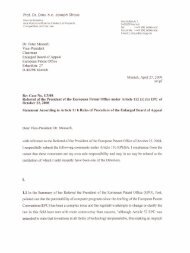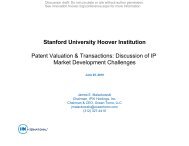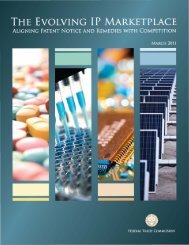Assessing the Obstacles to Industrialisation: The ... - Innovation
Assessing the Obstacles to Industrialisation: The ... - Innovation
Assessing the Obstacles to Industrialisation: The ... - Innovation
You also want an ePaper? Increase the reach of your titles
YUMPU automatically turns print PDFs into web optimized ePapers that Google loves.
6 Stephen H. Hailerthan 2,500 persons, indicating that <strong>the</strong>y were peasants who lived intraditional villages.' X good portion of this population (close <strong>to</strong> 60 % insome states) could not even speak Spanish, implying that <strong>the</strong>y functionedonly in local markets.' Finally, Coatsworth's national income estimates for<strong>the</strong> nineteenth century suggest an economy characterised by low incomelevels. Gross Domestic Product per capita in I 84j was only $56 (1950dollars), and was, as has previously been mentioned, shrinking.'' <strong>The</strong>market for manufactures would in fact have been even smaller than this$j6 figure indicates, since <strong>the</strong> nation's skewed distribution of wealth nodoubt produced an extremely uneven distribution of income. In fact, at<strong>the</strong> turn of <strong>the</strong> century, when real GDP per capita had doubled since I 845,average household incomes were still so low that in years of bad cornharvests, when <strong>the</strong> price of this important staple rose, Mexico's workingclass could not afford <strong>to</strong> purchase cot<strong>to</strong>n cloth."Not only was <strong>the</strong> market not conducive <strong>to</strong> <strong>the</strong> growth of manufacturing,nei<strong>the</strong>r was <strong>the</strong> legal-institutional environment. In <strong>the</strong> UnitedStates and England, for example, legal systems had developed in whichdecisions were based on precedent, in which judges made rulings based onpride in craft, and in which well-defined bodies of contract, commercialand patent laws were established. This made property rights, at least for<strong>the</strong> 'respectable classes', easy <strong>to</strong> protect. In Mexico no such state of affairsexisted. Until <strong>the</strong> last two decades of <strong>the</strong> nineteenth century no legislationexisted <strong>to</strong> encourage <strong>the</strong> formation of limited liability corporations, amodern patent law did not exist, nor was <strong>the</strong>re a body of mortgage creditlaw designed <strong>to</strong> protect long-term investments. Indeed, as was <strong>the</strong> case inearly modern Europe, economic activity of all kinds still required specialpermits and licences for which special taxes and fees were charged. Aboveall, litigants faced a corrupt and whimsical judicial system. Thus it wasextremely difficult <strong>to</strong> enforce contracts, collect on loans (especially if <strong>the</strong>ywere <strong>to</strong> <strong>the</strong> government) or enforce property rights without resorting <strong>to</strong>political machinations. As David Walker has pointed out in his work oncommerce in nineteenth-century Mexico, without access <strong>to</strong> those whoJames K.Wilkie, <strong>The</strong> ,ZIesican Revolution: Federal Expendrture and Social Change since 1910(Berkeley, 1970), p. 218.Vtreccion General de Estadistica, Estadisticas Socrales dei Porfiria<strong>to</strong>, 1877-1910 (hlextco,19)6), pp 118-20. <strong>The</strong> data are for 1895, when in <strong>the</strong> nation as a whole 17% of <strong>the</strong>population spoke only an indigenous language. <strong>The</strong> percentage of non-Spanishspeakers in <strong>the</strong> mid-nineteenth century was certainly significantly higher than <strong>the</strong> 1895figure. But even in 189j <strong>the</strong> majority of <strong>the</strong> populat<strong>to</strong>n in indian-dominated states likeYucatan and Oaxaca spoke only an tndigenous language. In seven o<strong>the</strong>r states (out ofji) over 20% of <strong>the</strong> populat<strong>to</strong>n spoke no Spantsh in 1895. It is highly likely that in<strong>the</strong> mtd-nineteenth century <strong>the</strong> nat<strong>to</strong>nal average approached <strong>the</strong> levels of <strong>the</strong>se states.lo Coatsworth, '<strong>Obstacles</strong> <strong>to</strong> Economic Growth', p. 82.I' El Economrsta ,Zlesicano, 7 >la)- 1904, p. I 14.





